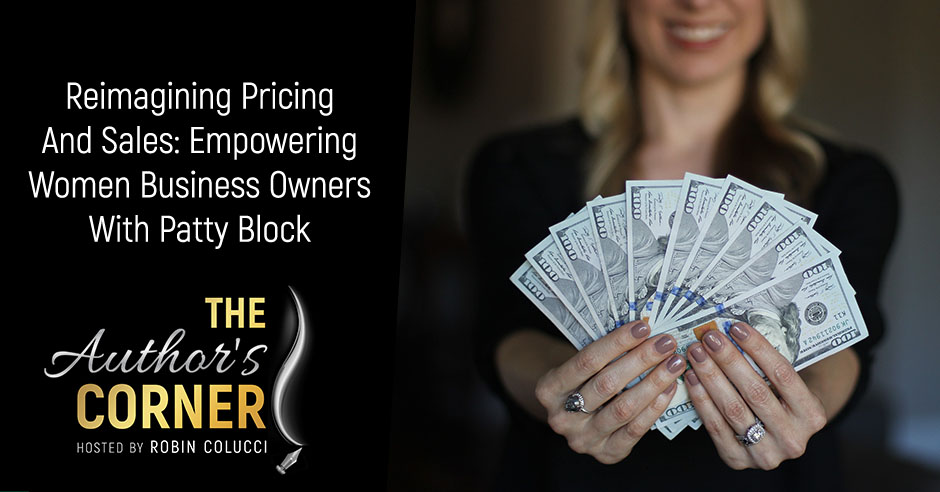
Financial empowerment often starts at one place: the value of your products or services. When you value yourself too low, that means a lower chance of profits and financial success. When this happens, you will need to start reimagining pricing and sales if you want to achieve financial freedom. Join our host Robin Colucci as she chats with the founder and President of The Block Group, Patty Block, about why you need to take a long, hard look at your pricing and sales models. Patty then discusses the need for value-driven pricing and talks about empowering women business owners.
—
Watch the episode here:
Listen to the podcast here:
Reimagining Pricing And Sales: Empowering Women Business Owners with Patty Block
I have with me the amazing Patty Block. She founded The Block Group in 2006 to empower women business owners who are experts in their fields. As their trusted advisor, she brings a unique perspective, having experienced and solved many of the same complex issues that women face as leaders, moms, daughters and sisters. Patty tells me that 62% of women business owners rely on their businesses for their primary income yet 88% of those businesses generate less than $100,000 in annual revenue.
Having seen the same struggles time and again, Patty decided to address this issue by teaching women how to shift their mindset and build their confidence to generate more revenue with less stress by reimagining pricing and selling. She is a firm believer that when women earn more, everyone benefits, their staff, families and community. Clients of Patty often refer to her as their business therapist and secret weapon.
By establishing long-term relationships and serving as a strategic sounding board for her clients, they experienced direct benefits to create real and lasting change, turning roadblocks into building blocks. I’ve invited Patty to talk with us specifically about this hurdle that many women business owners face around being able to generate substantial income to support themselves and often to support themselves and their families.
As somebody who was a single mom who received little support and was raising my two children and depending on my business for my primary income. I remember those early years being lean and challenging. I can remember one time in the grocery store with my kids, I was calculating in my mind what I was spending as I put stuff in the cart because I couldn’t go over $80 or else, I would wipe out my checking account. I understand how hard it can be. The big shift for me occurred also when I reimagined my pricing and sales.
That is when I went from barely eking out $40,000 gross a year in my business to get into the multiple six figures. I have a special connection to the importance of making this shift. It is my deep hope and desire that some of our readers especially our moms will get some great nuggets. If there are readers out there and you’re struggling at all with growing your business and getting that substantial income that allows you to live the life that you want. I hope that this episode will be of great use to you so enjoy.
—
Patty, welcome to show.
Thank you. I’m glad to be here.
I’m excited to have you. We’ve talked about the topic that we’re going to cover a little bit on the side. I think it’s an important topic and not something that’s written about or talked about a whole lot, which is this wage gap for women who are self-employed and women business owners. We hear about a lot in the corporate world, smashing the glass ceiling. This is interesting to me because it seems more like a self-imposed ceiling. I’m excited to dive right in. Let’s go back a little bit and share with our readers what triggered your interest in examining this particular issue.
It’s interesting, I’ve had my company since 2006 and I’ve observed with different companies and I work only with women business owners and typically, they’re experts in their fields. They’re highly educated and they put a lot of energy into building their careers. Often, they’ve come out of corporate and started companies. These companies have been in business for maybe 2 to 10 years and I started seeing patterns. The more I was working with women business owners, the more I listened, asked questions, did market research and the same things kept coming up over and over.

One of which was using an hourly billing model because that’s what they learned especially if they came out of corporate. Because I work with a lot in financial services or professional services, that is how they’re trained. Everything is done on an hourly billing model and I object to that because it’s transactional and yet, they’re all performing transformational services and helping their clients in these valuable ways but that isn’t being acknowledged. That was my first awareness many years ago. I started to see these patterns and hearing the same things over and over.
To your point, it’s self-limiting. No one else is imposing their structure or their rules on us as women business owners. We’re doing that to ourselves. I noticed there were several reasons for that. One is comfort. We default to, “This is where I’m most comfortable and I don’t know how to change it. It seems like a lot of work to try and figure it out.” That’s the first piece. The other piece is they want to avoid conflict and sometimes change feels like conflict. They’re afraid that people will push back or they’ll lose clients. There’s a lot of fear underneath that.
I’m wondering how much of this is also conditioned by how girls are raised and how women are taught to. How would you put it? To me, it smells a little bit that there’s a socialization aspect to this.
I think so, too. I know that’s how I was raised in a rather chauvinistic household where my dad was the boss and everybody deferred to him. He made it clear that my brothers were expected to be ambitious, be highly educated, has great careers, and be breadwinners. The girls were expected to get married and have kids. It’s fine if we got our education and if we had a career but the messaging was specific. On the one hand, that takes some pressure off us. My brothers always felt a lot of pressure to meet my dad’s expectations whereas I had different pressures.
Because it was clear that I was not expected to have a career or to build a company or whatever, I then felt somewhat rebellious. Let me show you how this is going to work. I did get married, have kids, built companies and I’m the breadwinner in my family. I had a unique circumstance in that I was 34 years old, had three little kids and a surprise divorce. It quickly became clear to me that I was on my own. I had built a company as a political consultant and a lobbyist but that required a lot of travel and I realized I needed to be home to stabilize my family. My youngest wasn’t even two at that time. I closed my business after eight years and I grieved over that. I took a job because I needed health insurance and I needed to stop traveling.
That was a great opportunity. I went to an international school and I became Director of Development and then Director of Operations. When I started this company in 2006, my goal was to bring that experience in finance and operations to the small business market. To your question, yes especially in Western culture, we are raised as women with different expectations and probably different expectations of ourselves.
I have to share. There are two things that occurred to me. One was when you’re talking about your rebellious desire to start your own business. I don’t remember who said it but I have this quote that I love which is, “Well-behaved women rarely make history.” That occurred to me. You were talking about how you had the surprise divorce and you had these three little kids. You couldn’t travel and you had to fold that business and take a job.
No one else is imposing their structure or their rules on us as women business owners. We're doing that to ourselves. Click To TweetIt immediately made me think of the phenomenon that we’ve seen as a result of the pandemic where more women have left the workplace. We have fewer women in the workplace now than we have since the 1980s. Even in dual-parent households for some reason, the women are the ones who chose but probably under a lot of external pressures to homeschool. When you were able to send children to school, they’re not going to school so it’s fallen upon the women to do the homeschooling.
I hear that frequently and I see it. I can’t imagine how I would have managed under those circumstances. I admire the women who are doing it now so much and I have several clients who are struggling with that exact issue. They’re running a company and it’s growing. They’re doing great. They’re juggling homeschooling, working from home and all of the complications that come with that. It has been a hectic time for a lot of families. There are also a lot of women starting companies because they’re leaving the workforce and they want a more flexible schedule.
Which is a benefit of being a self-employed woman. Let’s talk a little bit about the limiting beliefs that prevent women from charging what their services are worth. I avoid the phrase charge what you’re worth because that’s not possible because you are priceless. Charging what the service is worth and what you were alluding to this transformational value. Not trading dollars for hours. Before we get into the solution, what are some of the key limiting beliefs that you see come up for women when you’re talking with them about their rates and their rate structures? I know you touched on a few but give us a little bit more insight into what is the story that they’re telling themselves in their minds. What are the specific things they’re afraid are going to happen and start to command what they deserve?
To speak to your point about what you’re worth, I never use that term for the same reason you mentioned because then it conflates your self-esteem and what you’re charging. To me, it’s not only self-limiting but it’s self-deprecating. I’m based in Houston, Texas and we have a saying here in Texas, “It’s not bragging if it’s true.”
That should be Texas’ State motto.

Because of that, it’s one of the limiting beliefs. We as women think we’re bragging and it feels terrible. We feel embarrassed and self-conscious. One of the biggest issues is we think we’re bragging or we sound arrogant or we don’t want to talk about ourselves.
When we’re explaining the value that’s present, women tend to feel like they’re bragging versus showing the client the opportunity. A lot of women you’re working with are hearing that as like, “I’m just having an ego-fest.”
There’s that but also, I had one person asked me, “Am I putting a price on my head? Is that what I’m doing by focusing on increasing or improving my pricing?” I said, “It isn’t.” For the same reason, we don’t talk about what you’re worth because it’s not about you as a person and it’s not about your self-esteem. It’s about building value in the mind of your ideal buyer. There’s a different concept than charging “what you’re worth.”
Those self-limiting beliefs start with, “If I’m talking about myself or my education,” or I have a client who has a Harvard MBA and she doesn’t talk about it because it feels like bragging. What happens is we talk about our team, our service and how we can help this person that has come to us but we don’t talk about ourselves and we don’t talk about our accomplishments. How do we help other clients? What kind of results do we get? Because it feels like bragging.
That’s one of the biggest issues but the other is fear. There’s a false belief that they are charging “what the market will bear.” What I help them understand is there’s no such thing. It’s like charging what you’re worth, there’s no such thing. Yet, we keep worrying about these concepts and they’re not real. It’s like that big scary monster under your bed at night. It’s not real but you still feel scared. That’s what’s happening here, too. Because there’s fear under that, they don’t want to deal with changing their price. When I did my market research to find out what issues were the biggest challenges for women business owners, pricing never came up. No one ever answered pricing.
Say more about that. That’s interesting. What problems were they aware of?
What they talked about were problems with managing their staff or hiring or finding the right people. That was always a top concern. The other top concern was juggling, the number of things and the competing priorities that we have to deal with as women business owners especially family and not just children but parents. We are the sandwich generation and we’re helping our parents. I know I am. I have three kids and I’m always helping them as well.
There are all kinds of things that we have to prioritize and in addition to that, all the companies I work with, their businesses are growing. They have those challenges of finding the right people, hiring, managing and dealing with technology. They don’t have time to research and figure out the right CRM and migrate their data. I help them do that research, make those decisions, migrate their data and all of the operational pieces to managing their business. The other big challenge was, “I’m juggling a million things and I’m feeling burned out,” or, “I feel like my company’s running me and I’m not sure how to solve that dilemma.” Those were the things that were top of mind when I did the market research.
I remember something from a previous conversation we had that one of the questions you ask them, correct me if I’m wrong was, “If you got an infusion of cash like $100,000 or something like that into your business, how would you utilize that?” Can you share it with our readers a little bit? Because I thought this was fascinating.
I did ask that question. The funny thing is when I originally drafted the question, it was, “If you had an extra $250,000.”
We, as women, think we're bragging, and it feels terrible. We feel embarrassed and self-conscious. Click To TweetI way undershot that.
I changed it, Robin. I asked 1 or 2 people that question and they couldn’t answer it because that was such an immense amount of money in their mind that they thought that was impossible. I changed it to $100,000. The answer that I got was, “I would give all my staff a raise. I would hire two more people. I would have an annual retreat for my staff.” They started listing all these things of how they would support others. I would ask them, “Do you pay yourself last at the end of the month? Do you pay yourself first?” Universally, women pay themselves last. We pay everyone else first, all our vendors and all our staff. We make sure everything’s taken care of and then if there’s anything left over, we pay ourselves. That’s the first piece of that.
The second piece is I asked if they would give themselves a raise and they said, “I would hire more people.” One of the other patterns that I’ve seen over the years is as women, we often think we’re understaffed. When I go in and look at the productivity and who’s doing what inside the company, they’re overstaffed. I’m wondering what certain people are doing all day. It’s that comfort of as women, we often like to have a community. We like to have people around us and we want to delegate the work because we can’t handle everything.
When I asked the question, “If you had an extra $100,000, what would you do with it?” It was clear that the responses were, “I would support others.” Helping them shift their thinking is an important mission for me because it is limiting. There are many ways that you can generate more revenue with less stress, which is now my mantra, and how I teach that is it’s not just your pricing. It starts with pricing because that’s the linchpin for everything in a service company.
In addition to your pricing, if you treat sales, if you don’t think of it is as a four-letter word. Sell is not a four-letter word. If you understand that you’re taking your buyer on a journey then at the end of that journey, your buyer will be ready to buy. You don’t have to convince anyone of anything. It’s more like matchmaking. Shifting the mindset and helping women understand this differently and approach it differently is a process and it takes time and practice. That is what I teach and we see incredible results.
That is such a huge mindset shift when you realize. I had a wonderful mentor who used a phrase that I’ve reminded myself of I don’t even know how many times and it is, “Sales isn’t something you do to someone. It’s something you do for them.” It’s true because this person is coming to you in some sort of pain because they need a solution. If you have a great solution, it’s your responsibility to communicate. First of all, to listen to them and see is this an appropriate solution. If it is, communicate your solution and charge a price that supports you as well as them. You can’t deliver your best if you’re stressed, broke and worrying about how you’re going to pay your team and not even thinking about paying yourself. How much help can you be to somebody?
Here’s the other limiting belief that I’ll mention. Thinking that you’re greedy if you charge more. I saw that in my market research. A lot of women, when we drill down into how they felt about their pricing, what they were charging or how they communicated that, would often say, “Sometimes, I just feel greedy. I’m happy with what I have, what I’m doing and everything is fine.” I would hear it over and over and I still hear it all the time. “My pricing is fine.” It is fine if that’s all you want and if you’re okay with that limitation. If you are, more power to you.
One of the things that happen when you start generating more revenue is it empowers you as a person, woman, business owner and manager. That is exactly what happens with all the people that I’ve taught to improve their pricing and their sales efforts, that they start bringing in so much more revenue. They can reprioritize what they want to do, how they want to do it and how they want to communicate their message. It buys you power. It’s the power to choose, have choices, freedom, and flexibility. That’s what comes of it and it’s not about being greedy.
I’ve raised my prices several times. They’re on the higher end of the world of the book of consulting or coaching. One of the key values of women business owners is to support others and help create opportunities for others. I agree with that but what I have found is that raising my prices has enabled me to provide better opportunities to more people. I’ve got multiple people working with me on my team who are earning what I was earning on a yearly basis a few years ago but they’re 30 years younger than I am. I find that fulfilling to be able to not just provide people some work to do but my goal is to make sure that everyone on my team gets to the level where they have a nice living wage that they can enjoy their life with.

The real importance of that is when women earn more, we share that wealth. We support others and it’s coming back into our communities. We’re supporting our families. We’re supporting in terms of philanthropy and what we give back to our communities. It’s not to say that men don’t do that but women have that spark of building our communities and supporting that. That’s what happens when women earn more and bring in more revenue in their business. It gives you choices and the power to then impact your community in a whole new way.
I’m glad you shared that because something that I was hearing as the essence that was coming across in all of these points of view that women business owners who struggle with their rates are having. I kept thinking that this is what the mother does, like, “There’s not enough food for all of us so I’m going to let my children eat first and then I’ll eat what’s left.” It’s even appropriate for a mother but it’s that energy and desire to take care of. That’s a beautiful part of feminine energy but there is this point where these people aren’t your children.
When I was growing up, there was a standard thing in my household that mom always ate the broken cookies. Everybody else got the whole cookie and mom would eat the ones that were broken. That philosophy ties into what you’re saying that if there’s not enough food then mom makes sure that all her kids are fed first.
Probably her husband, too. If we look at the traditional model, dad gets the big pork chop and the chicken.
Some of this is about taking back your power, feeling empowered and not feeling afraid anymore. What women are often afraid of, even if they feel brave enough and ready to change their pricing and their sales efforts, is the communication piece. It’s, “How do I talk about this? How do I communicate it in a way that doesn’t sound like I’m bragging, doesn’t feel like I’m greedy and doesn’t scare people off because my prices are “too high?” I don’t want to lose clients. I don’t want to take a chance that I won’t attract clients.” The truth is as women, we believe that every buyer who comes to us is an ideal buyer. If we determine they’re not an ideal buyer, we believe we can turn them into one.
This is the old dysfunctional dating. Not the ideal boyfriend, “I can fix him and make him an ideal boyfriend.” Now we’ve carried that over to clients.
When we talk about building value in the mind of your ideal buyer, that’s where it gets tricky. If you believe that everyone who comes to you is an ideal buyer and you are struggling to help them understand the real value that you bring then you’re working on a false premise. Because they’re not an ideal buyer.
If they can’t see the value, they’re definitely not.
There are lots of reasons they might not be an ideal buyer. You have to be able to look at that honestly. I teach a process that helps you look at that whole process honestly. In addition, how you then communicate? How do you answer questions that may catch you off guard or make you feel uncomfortable? There’s a whole piece where communication is keeping women stuck. Instead of communicating, they’re staying quiet.
Even back to the ideal buyer thing, even energetically, if you’re going into every conversation thinking, “This is going to be the great client,” and you haven’t talked to them, you’re going to convey a more desperate, needy energy versus going into the conversation with more curiosity. How can I help this person get to another place of clarity? If the clarity is you should hire me, cool. If the clarity is you should not hire me, it’s also cool because the goal isn’t to get the client. I found that making that distinction took a lot of those fears that you’re talking about off the table because then it wasn’t about, “I have to get this person.” It was like, “Is this somebody I can help that I want to help?” If so then I offer them something. If not, I don’t. I try to find something else for them to try. It is like that non-attachment. What I’m getting from what you’re sharing is that there’s a strong sense of attachment to an outcome.
First, there’s hope. We hope that this turns into a client. There’s then that idea of if they’re not ideal, I can turn them into ideal. It then becomes not only hope in them but hope in ourselves. It then becomes, “I want the revenue. This would be a great client. I know I can do the work. I know I can deliver and I want the revenue.” Those three things inspire us to create situations where we wish we could fire a client.
You’re like, “There’s not enough money in the world for me to sign this person up again.”
Especially, Robin, if you haven’t fixed your pricing first, you’re essentially giving away your services.
It’s costing you much energetically that you can’t even put a number on that. You’re saying there are these different layers of hope and then the revenue. This has got to be plugged into the same thing that has them probably want to avoid sales conversations. It’s a vicious cycle because if you don’t have enough conversations then you do need to close every sale or you can’t pay your team. Without getting in too much, what is the different way of thinking about it that you advise women? I would imagine there’s some element of even a different perspective.
One thing that happens when you start generating more revenue is that it empowers you as a person, woman, business owner, and manager. Click To TweetIt’s several different pieces. One is understanding your relationship with money. That’s the thing we start with. I have a program called Value Driven Pricing. We start with your relationship with money. We then drill down into, what is your current mindset? What do you want it to be? How do you change it? I give tools and strategies for how you can shift your mindset. It’s one thing to hear what I’m saying and think, “That makes sense,” or, “I’m doing that.” It’s another thing to figure out how to change it. That means changing not only the way you’re thinking but also your habits, getting outside your comfort zone and being brave enough to take these steps. That’s how I view the people that I work with. My clients are brave. They’re ready and they’re willing to learn new things and try new things. The first piece of it is your relationship with money and your mindset.
We then start a different way of looking at who your ideal buyer. What makes them an ideal buyer and not a client? That’s different. I make that distinction. All the marketing companies talk about your ideal client, your avatar and all of these terms that they use. The problem I have with that is that it ties into hope, which can work against us. If you have somebody who comes to you and you’re thinking of them as an ideal client then you’re not going to be paying attention to their buying journey. You’re going to be trying to figure out in your mind how you’re going to provide the service and what you’re going to charge. As long as you’re focused on that, you’re not listening to your buyer.
I make that distinction to say, “Look for an ideal buyer.” Let’s make sure we understand who you’re looking for and where you’re going to find them. There’s a price point for every market and service. You made the comment that you’re probably at the higher end in your industry but there’s a price point for that buyer and then the key becomes going to find your buyer. That is what I teach. My clients, because they’re experts in their field, don’t want 5,000 clients. They want 50 or 5 clients.
When I got clear on who is the most appropriate client, I was able to cut out 80% of the networking I was doing because it was not in the right places. It’s a complete waste of time. Meeting nice people is always fun but that’s not business development time. That’s wasted business development time.
On top of that, we’re addressing the juggling and competing priorities problem. If you’re not going to 50 networking events a month then you can focus your energy in a different way and you become more productive. By productive, I mean making money.
It is what keeps the lights on.
It allows you to make choices and have a community impact.
Frankly, I was somebody who didn’t enjoy sales. I didn’t enjoy that moment when they finally say, “What’s it going to cost me?” I didn’t enjoy that part especially. I can relate to what you’re saying. There are lots of scary moments but I love doing sales. It’s one of my favorite things to do because helping someone who I know I can help and who’s going to change the world with their book and I get to help them get there, it’s fun.
I feel the same way.
I’m sure you do because you can see what’s on the other side for them. It’s fun to have that conversation, to explore it together and see if this is something we want to do together.
It’s more like matchmaking.
I love that analogy. That’s brilliant.
It’s more like, first of all, finding the ideal buyer and having those conversations in a structured way so that you’re taking them on this journey and you’re focused. I often advise my clients, “You have to separate sales from service.” What happens is we get focused on how are we going to provide the service and what are we going to charge that we abandon our buyers and they’re less likely to buy. Having that structure and that process is super important. Once you learn it and you practice it, it becomes second nature. It’s perfect for women because we love building relationships. The method that I teach is relationship building in the buying process.
Your buyer should be doing most of the talking. Interestingly, it sounds like, “We do this service. We offer you this. We give you this.” That sounds like bragging. When you show that you’re curious about the buyers’ experience, what they’re exactly looking for and what stopped them in the past, these questions they then will get, “This person’s interested in me.” When you have a solution, you can tailor what you share. They don’t have to know everything about your business. You can tailor what you share based on what they told you. It’s fun. Tell us a great success story, one of many I’m sure that you have, of a woman who came to you and was struggling with this and what happened.
I have a couple. One, in particular, is one of my favorite stories because she had been in business for such a long time. Her father had started the company then he passed away and she took over. The company had been around for over 30 years and was successful. I had been working with her for about three years. I had been talking about raising prices, structuring it differently, communicating it differently. She was hesitant for all the reasons we’ve talked about. She had a lot of fear and was concerned especially that she might lose clients.

One thing that’s important to know is regardless of what you decide to do with your pricing, you can leave your current clients alone. You can keep them exactly as they are with the structure they have and the pricing they have or you can grandfather them, what I like to call grandmothering. That’s exactly what she chose to do after we finally talked it through. The turning point for her was that I had developed a cashflow analysis for the next year. This was the end of the year. We were doing it for the next year. I showed her that if we assumed everything status quo, which is pretty much what it would be, that she would have a breakeven year.
She had a team of six people. She was shocked. She turned to me and said, “We are working way too hard not to have profit.” I said, “I agree with you completely. The simplest, quickest, most seamless way is to change your pricing.” We worked through that. We built her pricing models. She decided to grandmother her current clients and give them six months’ notice, at which point, the increase would go into account into place. She not only lost no clients but her sales also skyrocketed partially because she was communicating much better and focusing on her ideal buyer. She also found that as she was communicating this, she was getting more referrals. All of that, that next year where we had developed that cashflow analysis, it was her biggest revenue year in business in over 30 years. Two years later, when I suggested we raise prices again, there was no hesitation and fear because she had such a great experience with that.
Honestly, I found that as our pricing goes up so does the quality of the clients and their level of commitment.
That’s true and their sophistication. They do understand the value. When you’re working with a more sophisticated client, not only do they value you more because they understand this whole dynamic but also they have friends. They have colleagues. Those referrals are of better quality as well.
Success begets success. People who are in a position where they’re both willing and able to pay the higher rates, generally, what I find is these people value excellence because they provide excellence in their work. It’s important to them and they demonstrate that in their work every day. The truth is there’s not a lot of excellence out there. If you’re willing to be excellent in providing your services, they’re grateful to pay you for the excellence that you’re providing because it takes much pressure off of them. They don’t have to be behind you with the broom cleaning up your half-assed job.
You’re also saving them much time and energy. That’s true when my clients change their pricing or we streamline their operations or whatever we’re working on that they don’t want to take the time, energy and frustration of figuring it out themselves. I can streamline that for them and teach them how to do it. That’s the second story I wanted to share. One of the business owners in my pilot program for Value Driven Pricing had an interesting scenario.
She owns a PR company that has been in business for a few years. It’s successful. She’s got a team of people. The challenge for her has been identifying the red flags when it’s not an ideal buyer. It’s that hope that I can turn this person into an ideal buyer. She realized that she and her clients weren’t working well together. She had underpriced her services because often we undervalue ourselves and we underprice. Because of that, she wasn’t being profitable with those companies.
When we worked on her first proposal as she was taking the program, it was interesting because although she had that fear, all the fears we’ve talked about, she was willing to talk about that. The first step is awareness and being willing to talk about it and face your monster. Once she had done that, she was pricing a proposal for someone who had contacted her and wanted the work done in an extremely short period of time.
The way I teach them to build their pricing model and to scope the work is that you add in for urgency, for special requests and for things that you know the buyer values because they’ve told you. It’s important to them. That means you can charge more for that because they value it. That’s a good example of what I mean by building value in the mind of your ideal buyer. Take what they already value and then build on that. If someone says they need it in 30 days, there’s a premium for that.
You’re right because the thing I hear over and over again with my clients is their biggest challenge and their biggest obstacle is time.
That’s true for most of us.
They’re willing to pay to buy their time back.
You have proven yourself if you had a corporate career. If you own a business, you have proven yourself a million times over. Click To TweetOriginally, when I looked at her proposal, I said, “This is way too low. There are many things you’re not factoring in here. I think you should triple it.” She was horrified by that. What we did is in steps, I was able to help her understand how she could double it then how she could bring it up a little bit more where the value was and how to calculate that. I suggested that she go to a specific number and she couldn’t quite get there so she went $5,000 less. She gave the proposal. They didn’t bat an eye. All they asked was when could she start? What I said is, “You could have charged more.” That’s what that tells you. That was a good experience for her and a good lesson. Now, she doesn’t have those fears. She’s much more selective in who she’s working with. She is charging more appropriately, which changes everything in her company.
There is such a thing as not charging enough that it makes some potential clients and potentially your best clients think that you probably don’t have the skill level that they need. If you charge too low, they’re going to assume that you’re new or that you don’t know what you’re doing.
That could be. Especially for some of the companies that I work with that have been in business for three years, they have some of those insecurities of, “I haven’t proven myself yet so I need to do more things for less money. I get the experience. I then can start charging more.” What I help them understand is that is a self-deprecating and flawed way of thinking that is limiting. It is unnecessary. You have proven yourself if you had a corporate career. If you owned a business, you have proven yourself a million times over. You don’t need to keep doing that.
This has been helpful. Before I let you go, Patty, tell us how we can find you. I’m positive that there’s a lot of women who may have read a little something that sounded vaguely familiar. How can they find you to get some more help and support and charging appropriately for their amazing work?
You can connect with me on LinkedIn at Patty Block. Connect with me on LinkedIn. I love meeting new people. When you do, send me a little note that mentions that you read this blog and you’re curious. Also, you can contact me through my website, which is TheBlockGroup.net. Also, I have a quiz. I would love it if your readers want to take the quiz. What it does is reveal the roadblocks that you’re experiencing to generating more revenue. It’s called MyRevenueRoadblocks.com. It’s a free quiz. You can go and you’ll get a report. It’ll tell you what your score is telling you about what’s in your way in terms of building revenue.
That sounds great. I’m going to go take that quiz because we’re doing well but you can always do better. Thank you for sharing that. Thank you for your presence.
That’s great. Thank you. This has been great.
Thank you for being here with us.
Important Links:
- The Block Group
- Patty Block – LinkedIn
- MyRevenueRoadblocks.com
About Patty Block
 In 2006, Patty founded The Block Group to empower women business owners who are experts in their fields. As their trusted advisor, she brings a unique perspective, having experienced and solved many of the same complex issues women face, as leaders, as moms, daughters and sisters.
In 2006, Patty founded The Block Group to empower women business owners who are experts in their fields. As their trusted advisor, she brings a unique perspective, having experienced and solved many of the same complex issues women face, as leaders, as moms, daughters and sisters.
62% of women rely on their businesses for their primary income, yet 88% of these businesses generate less than $100,000 in annual revenue. Having seen the same struggles time and again, Patty teaches women how to shift their mindset and build their confidence to generate more revenue with less stress by reimagining pricing and selling.
She’s a firm believer that, when women earn more, everyone around them benefits – their staff, their family and their community. Her life journey–the good and the bad–allows her to course-correct clients by leading and advising with compassion, empathy and quiet resolve.
The result is a partnership of unbiased accountability, helping women position their companies–financially, operationally, technologically–for game-changing results. Patty raised three fantastic kids, all of whom have launched their careers and also work in Patty’s company (she essentially raised her own workforce!) Clients often refer to Patty as their “business therapist” and “secret weapon.”
By establishing long-term relationships and serving as a strategic sounding board, clients experience direct benefits to create real and lasting change, turning roadblocks into building blocks.
Love the show? Subscribe, rate, review, and share!
Join The Author’s Corner Community today:




